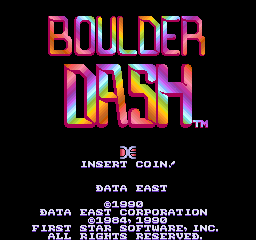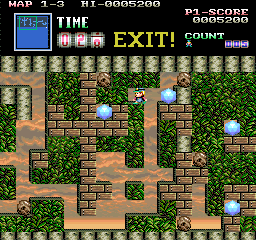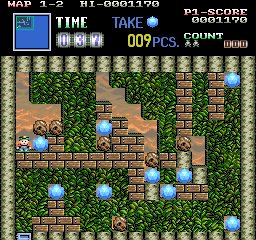Boulder Dash / Boulder Dash Part 2 for Arcade
Arcade1990, Data East Corporation - an updated version of Boulder Dash. This version features five worlds (four levels each) which can be freely chosen when beginning the game as well as a sixth which opens up when the others are beaten. Boulder Dash: Part Two is a hard mode with level edits of the regular levels (more diamonds to collect, different enemy placement, etc.).
Game controls in browser
Show Controller & SystemClick on play Arcade game now button first to load the game into the emulator. Before the start do not forget to toss the coin first (key 1) into the machine slot. Arcade controls:
Boulder Dash
Online version of Boulder Dash for Arcade. Boulder Dash, aka Rockford, was originally created by Peter Liepa and Chris Gray. The hero of the game, whom the player controls, is the brave prospector "Rockford". He must dig through caves collecting gems and diamonds, while avoiding various types of dangerous creatures as well as obstacles like falling rocks and the constant danger of being crushed or trapped by an avalanche, or killed by an underground explosion...
Game details
Other platforms online 7
You can play Boulder Dash online also in a versions for70%
rating (32 users voted)
Covers - Box Art
Arcade game
Online emulated version of Boulder Dash was originally developed as arcade game or coin-op game,
a coin-operated entertainment machine typically installed in public businesses such as restaurants, bars and amusement arcades. Most arcade games are video games,
pinball machines, electro-mechanical games, redemption games or merchandisers. While exact dates are debated, the golden age of arcade video games is usually defined
as a period beginning sometime in the late 1970s and ending sometime in the mid-1980s.
Virtually all modern arcade games (other than the very traditional Midway-type games at county fairs) make extensive use of solid state electronics,
integrated circuits and cathode-ray tube screens. In the past, coin-operated arcade video games generally used custom per-game hardware often with multiple CPUs,
highly specialized sound and graphics chips, and the latest in expensive computer graphics display technology. This allowed arcade system boards to produce
more complex graphics and sound than what was then possible on video game consoles or personal computers, which is no longer the case in the 2010s.
This emulation is powered by MAME (Multiple Arcade Machine Emulator) project, an open-source emulator designed to recreate the hardware of arcade game systems in software on modern personal computers and other platforms. Its intention is to preserve gaming history by preventing vintage games from being lost or forgotten.




